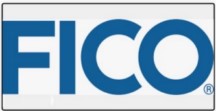It’s highly related to the US consumer finance industry
I previously published the blog article “Three major consumer credit rating companies Equifax, Experian, and TransUnion“, and introduced the three major consumer credit rating companies in the United States. This article will introduce you to one of the most important listed companies in the US consumer finance industry, Fair Isaac (ticker: FICO).
The reason why it is important is that all companies engaged in consumer finance related businesses in the United States, from banks to credit cards, loan companies almost all have to rely on its services. Fair Isaac disclosed previously 90% of US banks, credit card and loan companies are its customers. It is almost impossible for people living in the United States not to have heard of this company ─ because your credit score is the masterpiece of this company.
Stock performance
How did investors react? Its stock price has risen by 908% in the past 10 years, and it has also risen by 248% in the past five years.

Dissatisfaction caused by Fair Isaac’s monopoly
The three major consumer credit rating companies, Equifax (ticker: EFX), Experian (ticker: EXPGY), and Transunion (ticker: TRU), love it and hate it because they rely too much on its services to get rid of Fair Isaac. They not only sued it for antitrust reasons; the three companies also jointly established a company VantageScore Solutions.
The company came to fight Fair Isaac, but after several years of market proof, so far, it has not had a significant impact on Fair Isaac. The reason is that the market is large enough, but another more important reason is that Fair Isaac’s switching cost moat has been formed. There is no major problem with things, and no customers will want to change. In short, Fair Isaac has strong competitiveness and monopoly like Visa (ticker: V) or Mastercard (ticker: MA).
New rivals raise
Now some new financial technology companies have indeed begun to appear, such as Upstart (ticker: UPST), Lemonade (ticker: LMND), instead of using the traditional three major credit reviews or Fair Isaac’s evaluation, they use artificial intelligence algorithm written by themselves. Judging by the algorithm, this trend has just begun and has not yet formed a fatal threat. In the foreseeable future, there is still no way to take away Fair Isaac’s existing customers.
But from this we can also see how proliferation of the privacy, whereabouts, and daily information of you and me that the Internet and technology giants have, and it is getting more and more serious; this phenomenon is all true. My personal view is that these technology giants and financial technology companies will sooner or later produce products that are more competitive than Fair Isaac. In fact, this competition has already begun – for example, in mainland China.
Industry peers in China
Because the financial modernization in mainland China is later than in the Western countries, there has never been a company like Fair Isaac in mainland China. This is why the Sesame Credit of Ants under the Alibaba (ticker: BABA) group is very valuable. Because it is the only non-SOE and large-scale consumer credit rating company in mainland China; the other companies are at different levels in terms of technology and scale, and are not rivals at all.

Sesame Credit is a natural product that combines the information held by Fair Isaac and Alibaba. Therefore, after Ant’s initial public listing case was suspended, mainland China has asked Ant to separate Sesame Credit and place it under official control (not yet fully finalized, but the direction has been determined). Ant’s Sesame Credit is mainly based on the purchase details and preferences of Internet merchants owned by Alibaba for nearly two decades, plus Huabei (a consumer BNPL product), and Ant’s MyBank. MyBank’s main business is microfinance for small and medium-sized enterprises. It has nearly 90 million small business customers, almost equal to the total number of small and medium-sized enterprises in mainland China.
Related articles
- “Three major consumer credit rating companies Equifax, Experian, and TransUnion“
- “Fair Isaac, one of the most important listed companies in the US consumer finance industry
Disclaimer
- The content of this site is the author’s personal opinions and is for reference only. I am not responsible for the correctness, opinions, and immediacy of the content and information of the article. Readers must make their own judgments.
- I shall not be liable for any damages or other legal liabilities for the direct or indirect losses caused by the readers’ direct or indirect reliance on and reference to the information on this site, or all the responsibilities arising therefrom, as a result of any investment behavior.